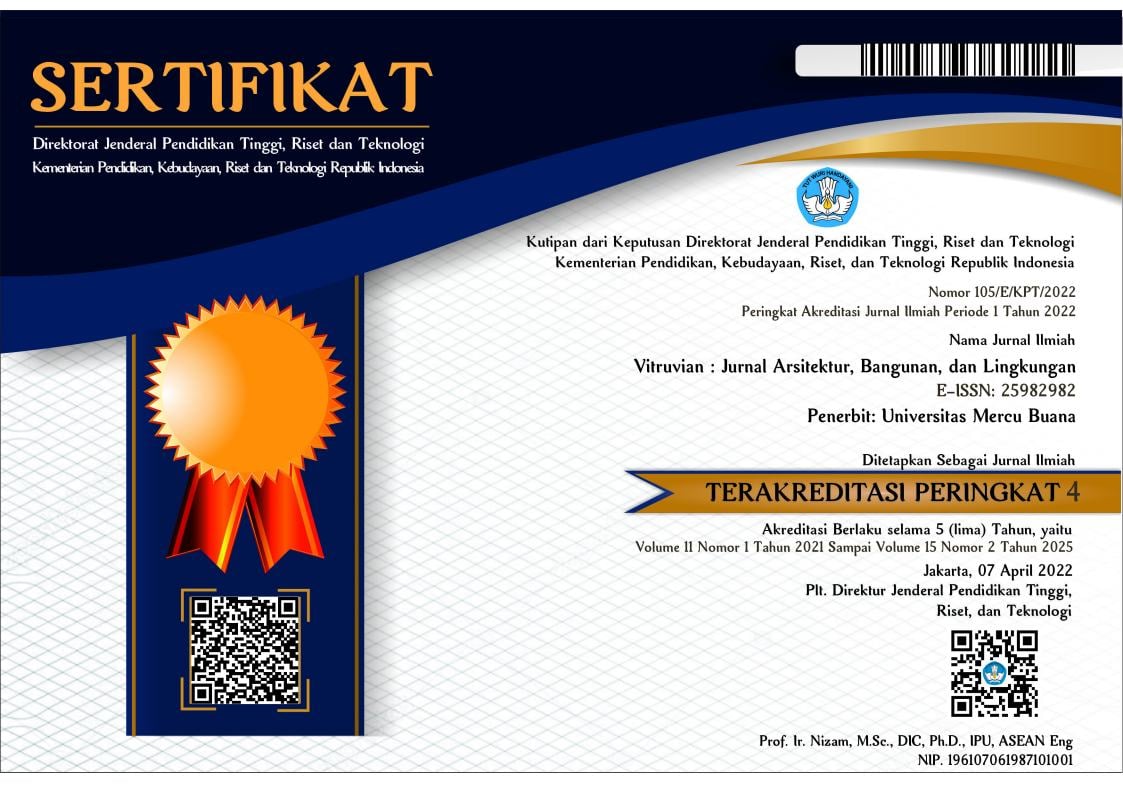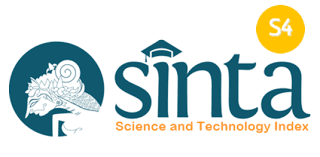PERSEPSI DAN WAWASAN MASYARAKAT TERHADAP IMPLEMENTASI PENDEKATAN BIOMIMIKRI PADA DESAIN BANGUNAN PERKANTORAN
Abstract
Bangunan dengan fungsi perkantoran semakin memberikan dampak negatif terhadap lingkungan dikarenakan intensitas konsumsi energi yang tinggi menghasilkan emisi karbon yang juga tinggi. Solusi nyata sangat dibutuhkan, disatu sisi ada pendekatan desain Biomimikri yang meniru elemen alam untuk menciptakan solusi inovatif dan berkelanjutan. Dalam arsitektur, biomimikri menghadirkan cara efektif untuk mengatasi tantangan desain dengan memanfaatkan prinsip-prinsip ekosistem yang telah terbentuk selama miliaran tahun. Pada desain perkantoran, biomimikri berperan penting dalam menciptakan ruang kerja efisien, nyaman, dan berkelanjutan, misalnya melalui ventilasi yang terinspirasi sistem pernapasan tumbuhan atau optimalisasi cahaya alami untuk mengurangi konsumsi energi dan mengingkatkan efisiensi energi. Pendekatan ini juga menawarkan solusi adaptif terhadap kebutuhan modern, seperti fleksibilitas ruang kerja pascapandemi yang menggabungkan model kerja hibrida. Penelitian ini bertujuan mengkaji pemahaman masyarakat produktif terhadap penerapan biomimikri pada desain perkantoran, khususnya dalam efisiensi energi, kenyamanan termal, dan pengelolaan sumber daya. Dengan menggunakan pendekatan metode campuran (mixed-methods) yang dimulai dari survei kualitatif untuk eksplorasi tema dilanjutkan dengan survei kuantitatif untuk menguji hipotesis. Penelitian ini mengidentifikasi dua dimensi utama yaitu Daya Tarik Inovasi dan Fungsional dan Daya Tarik Pasar dan Sosial yang memiliki pengaruh signifikan terhadap kecenderungan penerimaan desain Biomimikri. Hasil tersebut selaras dengan prinsip Technology Acceptance Model (TAM) yang menyatakan bahwa perceived usefulness dan social/image influence merupakan determinan utama dalam penerimaan inovasi.
Keywords
Full Text:
PDF (Bahasa Indonesia)References
Altman, I., & Chemers, M. M. (1980). Culture and Environment. Monterey, CA: Brooks/Cole Publishing Company.
Anwar, Sanusi. 2016. Metodologi Penelitian Bisnis. Cetakan Keenam. Jakarta: Salemba Empat.
Arnarson, P. (2011). Biomimicry. Reykjaví¿ k University.
Arrow, K. J. (1972). Economic welfare and the allocation of resources for invention (pp. 219-236). Macmillan Education UK.
Ataide, R. M., & Gallagher, C. L. (2013). Bioinspiration: an economic progress report. Fermanian Business and Economic Institute.
Bae, H. (2023). Biomimicry industry and patent trends. Biomimetics, 8(3), 288.
Budiasih, I Gusti, A, N. 2014. Metode Grounded Theory Dalam Riset Kualitatif. Jurnal Ilmiah Akuntansi dan Bisnis. 9 (1), 19-27.
Creswell, John, W. 2008. Research Design: Qualitative, Quantitative, and Mixed Methods Approaches. California: Sage Publications, Inc.
Davis, F. D. (1989). Perceived usefulness, perceived ease of use, and user acceptance of information technology. MIS Quarterly, 13(3), 319–340.
Gamage, A., & Hyde, R. (2012). A model based on Biomimicry to enhance ecologically sustainable design. Architectural Science Review, 55(3), 224-235.
Goss, D., Penick, C. A., Grishin, A., & Bhate, D. (2022). Bio-inspired design and additive manufacturing of cellular materials. In Biomimicry for aerospace (pp. 141-185). Elsevier.
Helms, M., Vattam, S. S., & Goel, A. K. (2009). Biologically inspired design: process and products. Design studies, 30(5), 606-622.
Hastrich, C. (2006). The biomimicry design spiral. Biomimicry Newsletter, 4(1), 5-6
Kadri, L. B. (2012). Towards the LIVING envelope: Biomimetics for building envelope adaptation.
Kennedy, E. B., & Marting, T. A. (2016). Biomimicry: Streamlining the Front End of Innovation for Environmentally Sustainable Products: Biomimicry can be a powerful design tool to support sustainability-driven product development in the front end of innovation. Research-Technology Management, 59(4), 40-48
Kumar, Ranjit. 2005. Research Metodology, A Step by Step Guide for Beginners. London: Sage Publications.
Lebdioui, A. (2022). Nature-inspired innovation policy: Biomimicry as a pathway to leverage biodiversity for economic development. Ecological Economics, 202, 107585.
Lee, K. (2013). Schumpeterian analysis of economic catch-up: Knowledge, path-creation, and the middle-income trap. Cambridge University Press.
Lenton, T. M., Xu, C., Abrams, J. F., Ghadiali, A., Loriani, S., Sakschewski, B., ... & Scheffer, M. (2023). Quantifying the human cost of global warming. Nature Sustainability, 6(10), 1237-1247
Liedtka, J. (2015). Perspective: Linking Design Thinking with Innovation Outcomes through Cognitive Bias Reduction. Journal of Product Innovation Management, 32(6), 925–938.
López, M., Rubio, R., Martín, S., & Croxford, B. (2017). How plants inspire façades. From plants to architecture: Biomimetic principles for the development of adaptive architectural envelopes. Renewable and Sustainable Energy Reviews, 67, 692-703.
Mantesi, E., Chmutina, K., & Goodier, C. (2022). The office of the future: Operational energy consumption in the post-pandemic era. Energy Research & Social Science, 87, 102472.
Moscovici, S. (1973). Foreword. In C. Herzlich, Health and illness: A social psychological analysis (pp. ix–xiv). London: Academic Press.
Oguntona, O. A., & Aigbavboa, C. O. (2023). Nature inspiration, imitation, and emulation: Biomimicry thinking path to sustainability in the construction industry. Frontiers in Built Environment, 9, 1085979.
Reed, P. A. (2004). A paradigm shift: Biomimicry. The technology teacher, 63(4), 23-27.
Rogers, E. M. (2003). Diffusion of innovations (5th ed.). Free Press.
Sadineni, S. B., Madala, S., & Boehm, R. F. (2011). Passive building energy savings: A review of building envelope components. Renewable and sustainable energy reviews, 15(8), 3617-3631.
Shapiro, H., & Taylor, L. (1990). The state and industrial strategy. World development, 18(6), 861-878.
Shu, L. H., Ueda, K., Chiu, I., & Cheong, H. (2011). Biologically inspired design. CIRP annals, 60(2), 673-693.
Sommese, F., Badarnah, L., & Ausiello, G. (2022). A critical review of biomimetic building envelopes: towards a bio-adaptive model from nature to architecture. Renewable and Sustainable Energy Reviews, 169, 112850.
Stoneman, P. (1983). The economic analysis of technological change. (No Title).
Swanson, T. (1996). The reliance of northern economies on southern biodiversity: biodiversity as information. Ecological Economics, 17(1), 1-8.
Tractinsky, N., Katz, A. S., & Ikar, D. (2000). What is beautiful is usable. Interacting with Computers, 13(2), 127–145.
United Nations Environment Programme. (2022). Global Status Report for Buildings and Construction: towards a Zero-Emission, Efficient and Resilient Buildings and Construction Sector. Nairobi.
United Nations Environment Programme. (2021). Emissions Gap Report 2021: The Heat Is On—A World of Climate Promises Not Yet Delivered
Vincent, J. F., Bogatyreva, O. A., Bogatyrev, N. R., Bowyer, A., & Pahl,
A. K. (2006). Biomimetics: its practice and theory. Journal of the Royal Society Interface, 3(9), 471-482.
Wommer, K., & Wanieck, K. (2022). Biomimetic Research for Applications Addressing Technical Environmental Protection. Biomimetics, 7(4), 182. https://doi.org/10.3390/biomimetics7040182
Zari, M. P. (2007, November). Biomimetic approaches to architectural design for increased sustainability. In The SB07 NZ sustainable building conference (No. 033).
DOI: http://dx.doi.org/10.22441/vitruvian.2025.v15i2.010
Refbacks
- There are currently no refbacks.
Copyright (c) 2025 Vitruvian : Jurnal Arsitektur, Bangunan dan Lingkungan
License URL: https://publikasi.mercubuana.ac.id/index.php/virtuvian/editor/viewMetadata/33419
Layout Jurnal Vitruvian:Download
Declaration & CTA Form Vitruvian:Download
(WAJIB DI UPLOAD SEBAGAI SUPLEMENTARY SAAT SUBMIT ARTIKEL)
Vitruvian
Program Studi Arsitektur
Fakultas Teknik Universitas Mercu Buana
Jl. Raya Meruya Selatan, Kembangan, Jakarta 11650
Tlp./Fax : +62215871335
Surel : [email protected]
p-ISSN : 2088-8201
e-ISSN : 2598-2982
Website : http://publikasi.mercubuana.ac.id/index.php/virtuvian
DOI : 10.22441/vitruvian
Vitruvian is indexed by the following abstracting and indexing services:

This work is licensed under a Creative Commons Attribution-NonCommercial 4.0 International License.








